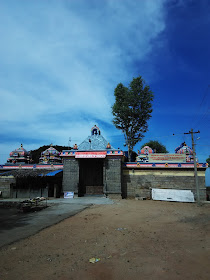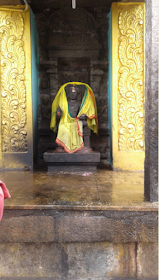Agneeswarar Temple, Thirukkollikkadu – The Temple
The temple covers an area of about 1 acre and is facing
west. The shrine for Lord Shiva is facing west. There is no Raja gopuram. Lord
Shiva is Swayambumurthy in the temple. Presiding Deity is called as
Theevannanathar / Agneeswarar / Thirukollikadar. The moolavar is of slight red
in colour and short. Mother is called as Panjinum Melladiammai / Miruthu Paatha
Nayagi / Menthiruvadiamman. Theertham is Agni Theertham.
Traditionally, Navagrahas in Shiva temples do not look
at each other but different directions. It is noteworthy that they are in the
form of letter PA in Tamil thus facing one another. As Lord directly destroys
the sins of his devotees, the Navagrahas have less work, they are in a face to
face position, it is said. Lord Muruga graces here with a bow as Danus
Subramanya – Danus in Sanskrit means bow.
It is noteworthy that Sani Bhagwan shrine is close to
the shrine of Mother Mahalakshmi. He is called as Pongu Saneeswarar and is
situated at the North West corner of the temple where, generally the Sannathi
of Mahalakshmi is in other temples. Sri Sani Bhagavan took the duty of Sri
Mahalakshmi to bless the devotees. In all temples, Sri Sani Bhagavan has bow
and arrow or Soolam or whip in his hand. Here Sani Bhagwan is holding a plough
as if respecting dignity of labour.
Devotees pray to him all the days including the usual
Saturdays. They perform archana with Vanni leaves for favourable results. It is
noteworthy that the temple is facing west which belongs to Saturn in the zodiac
circle. Devotees throng the temple for relief from Saturn adverse effects.
The idol is seen with Kalappai or plough (right) & crow (left) in his upper
two arms, left hand by his side as Ooru Hastham and the right hand as abhaya Hastham
(Anugraha Murti).
Offer of Oomantham flower to Lord Sani here is said to
cure mentally afflicted devotees. On performing pooja with Vanni leaf he will
shower wealth and on offering Kondrai flower he will bless devotees with peace
& unity in the family. Only on Saturdays, the temple remains open even in
the afternoon. Bairavar Sannathi is situated in the north east corner of the
temple opposite to Sani Bhagavan Sannathi. Bairavar is the Guru of Sani Bhagavan.
As the disciple is in the vision of his Guru always, he benefits the devotees
with all his might.
Brahma, Lingothbavar, Dhakshinamoorthy, Vinayagar and
Durgai are the Koshta Idols. Stucco Image of Thiripura Chakravarthy worshiping
Lord Shiva is worth to watch in this temple. There are Urchavar Idols of Natarajar,
Sivakami, Saneeswarar with his vahanam and Vinayagar. There are inscriptions in
this temple which suggest that this ancient temple which was once built
out of bricks, got its present granite structure during the medieval
period of Chola reign, about 1500 years ago.
The temple has three sacred trees Vanni, Oomathai and
Kondrai representing wealth, removal of mental agony and unity in family
respectively. Sthala Vriksham is Vanni Tree. The Vanni tree (Botanical
name - Prosopis cineraria) is called Shami in Sanskrit; Banni Mara in Kannada,
Vahnni in Malayalam is one of the most sacred trees in India which has very
high spiritual values. This is the tree for lord Saneeswara. When a devotee
made poojas with leaves of this tree, he will get cleared by all his sins and
get a wealthy life.
The Oomathai (Botanical name-Datura metal) is another Sthala
Virutcham of this temple. Doing poojas with the flower of this tree benefits
the people with mental disturbances. There is one more Sthala Virutcham for
this temple - Kondrai Maram (botanical name-Cassia siamea). Poojas with the
flower of this tree will bring the divided families unite together.












































